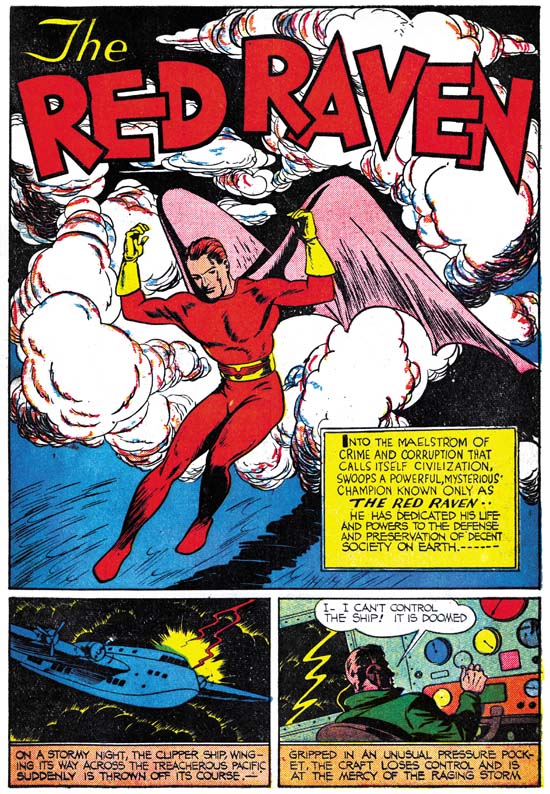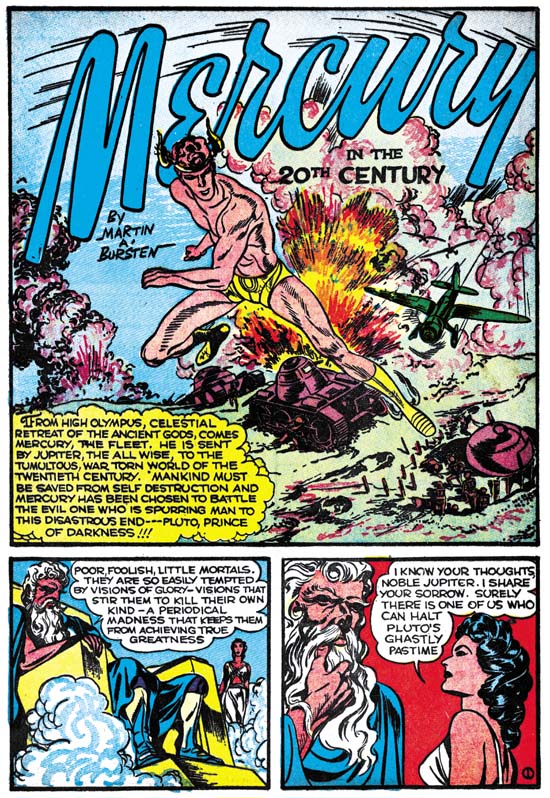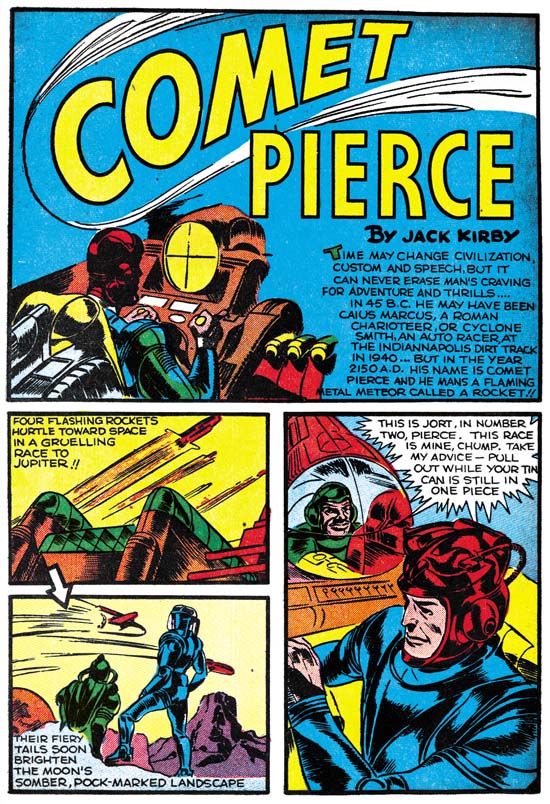
Red Raven Comics #1 (August 1940)
Joe Simon’s last set of covers for Fox Comics were cover dated July 1940. Joe went on to become art editor for Timely. When Joe arrived, Timely had three superhero titles. Marvel Mystery Comics was their big seller, largely due to the Human Torch and Sub-Mariner features. The other two titles, Daring Mystery and Mystic Comics do not appear to have been as successful. Each presented a dazzling assortment of features that would last only a few issues before disappearing. Previously Joe had done some work Daring Mystery through Funnies Inc, the shop that created the art for all Timely’s comics. (see my posts on Daring Mystery #2 and Daring Mystery #3). Now Timely’s owner Martin Goodman wanted to cut out the middleman and set up his own art shop. Although an editor, Joe worked on a freelance basis.

Science Comics #5 (June 1940) by Joe Simon
Previous Timely comics had been anthologies, but Joe’s greatest success so far had been with Blue Bolt. Blue Bolt was an anthology also but was named after the key feature. Joe convinced Goodman to do the same thing with a new hero, the Red Raven. While at Fox Comics, Joe had drawn a similar flying figure called the Eagle for the cover of Science Comics #5 (June 1940). But the success of Timely’s new title would depend largely on the key feature. Joe had to make sure the Red Raven story was especially good. The story would be 17 pages long, seven pages more then any other of the features in the comic. But surprisingly the Red Raven story was drawn by an unidentified artist. Jack Kirby drew the cover for Red Raven #1 along with two of the stories, so it is clear that he was available to do work. At this point Kirby was already doing all the drawing for Blue Bolt and was clearly a much better artist then the one Joe actually used. I can understand that as editor Joe might not want to draw it himself, but why did he not turn to Jack for this?

Red Raven Comics #1 (August 1940) “The Red Raven” by unidentified artist
According to Joe and Jim Simon’s book, “The Comic Book Makers”, Jack Kirby did not immediately follow Joe to Timely but continued at Fox. In the book Joe says it took three months. The last Blue Beetle strip that Jack did was published on March 9, 1940. Syndication strips are usually created only a week or so before publication. Comic books take longer to be created and the covers are dated with the removal time, not the distribution date. The result of all this is that comics will have a cover date that is five to six months after work started. This means that the first comics that Jack worked on after Fox would be cover dated August or September. I believe that Joe is right about Jack staying at Fox but perhaps it was not for a period of months but actually weeks. If when Joe started work on the Red Raven Jack was only available on a moonlight basis Joe might have reluctant to use him for the all important feature story. By the time Jack transferred to Timely it was too late to change artists.

Red Raven Comics #1 (August 1940) “Mercury in the 20th Century”
The credit given for “Mercury in the 20th Century” go to the writer, Martin A. Bursten (actually spelt Burstein). This is Kirby’s earliest foray into a feature loosely based on mythological characters. The hero is of course Mercury and his adversary is Pluto. Pluto is causing havoc in the world and has taken the mortal disguise of Rudolph Hedler, leader of Prussland. America was still at peace, but Europe certainly was not. In this story Mercury uses his powers as a god to thwart Pluto war promoting activities.

Red Raven Comics #1 (August 1940) “Mercury in the 20th Century” page 7
Inking on this story is different from that on Jack’s pervious comic book work. The inking used to define the form is lighter. Further spotting is not limited to form, but includes shadows and design aspects. Page 7 shown above provides good examples. Although Jack did not limit spotting to form when working for Blue Beetle or Lightn’ and the Lone Rider the way it was used in those works was different then what was done here. I believe someone other then Jack did the inking for this Mercury story.
In panel 4 from page 7 of “Mercury in the 20th Century” notice the large size of the man on our left. Similar large ears on people viewed from behind was a Kirby trait in the future during the years he and Joe worked at DC. But it also shows up occasionally at other times, the image above is perhaps the earliest example. But this trait is not as common during Jack’s period at Timely. This is because during this time Jack would not use this viewpoint as often and when he did he would not always get the ear size wrong.

Red Raven Comics #1 (August 1940) “Comet Pierce”
Jack also provided a science fiction feature, Comet Pierce. In many ways this story is written and drawn very much like his previous sci-fi work. The biggest difference is before the hero was a sort of sheriff of the stars while here Comet Pierce is a rocket ship racer. Once again lots of flying rockets, monsters and of course a beautiful woman. Even the inking is similar to the earlier work in that it is largely limited to describing form. But “Comet Pierce” is even more important in that for the first time a story credit’s uses the newly acquired name of Jack Kirby. The credit is for Jack alone, not for Simon and Kirby. Yet another reminder that although Joe and Jack worked together for Blue Bolt, they were not yet truly a team.
But the Red Raven title only lasted one issue. Because of the amount of time it took to get a comic book published, three months, it it clear that Red Raven Comics was discontinued well before any idea could be made about how well it would sell. Martin Goodman may have liked the idea about having a comic title dedicated to one key hero but he may have gotten cold feet about basing a comic on a new, untried, character. Instead it was decided to start a title for the successful Human Torch and (to save money on a new mailing permit) take over the numbering from the Red Raven. The first Human Torch would therefore be issue #2 and would be cover dated as Fall 1940.


Hi Harry,
Happy New Year!!! Just a couple comments on your early Kirby post.
The artist who drew the Red Raven story was Louis Casenueve,who interestingly was also the artist who replaced Kirby on the Blue Beetle strip. As Joe was the editor at Fox, I assume it was his decision to replace Kirby,(perhaps not) perhaps with the new freelance work, Joe figured he could keep Jack busy with other work. It is possible that Joe was hoping that Louis would develope into a major artist in Joe’s new stable at Timely, (along with Kirby, the 2 Al’s, and others) Louis would do a lot of work for Al Harvey (along with brother Arturo) when Harvey Pub. started up.
It’s also possible that with Kirby doing most of the pencils for Blue Bolt, the new Lone Rider pages, 2 new strips in the back of the Red Raven book, plus a new character showing up the next month (Marvel Boy) and some work on Fiery Mask, that, though he was fast, he might not have been that fast at that time in his career. So another artist was chosen for the RR strip.
As an editor, why put all your eggs in one basket, (though Kirby was one hell of a basket)
I do question your statement about the lead time for newspaper strips, such as Blue Beetle. You give it as a week or 2. I have always read that it was more like 6-7 weeks lead time. I do know that SkyMaster had a 6 week lead time. Is it possible that smaller run strips such as Socko the Seadog, or Blue Beetle could make it with a 2 week lead time? Anyone know for sure?
Best
Stan
Stan,
Happy New Year indeed!
I still think not using Kirby for the Red Raven story has to be explained and that the explanation I gave sounds correct. I believe Kirby’s speed has been overrated but if he did two backup stories he could have done the Red Raven story (with the backups going to someone else).
It really would be good to know what the correct lead time was for syndication was. It has a lot of bearing on what was going on Kirby’s early career.
Harry
Hey,
I’ve been looking everywhere for an online copy of Red Raven #1 but it seems to be impossible to find. Could you possibly send me your scans of it? I’ve been reading through the Golden Age in sequence and was hoping that I would be able to avoid any gaps in the publication.
-Mike.
Mike,
Sorry, but my understanding is that it is not public domain. I did provide scans to Marvel so hopefully someday they will republish it.
Thanks for your attention, Harry. I figured it was worth a shot. It’s too bad that fans who are just interested in reading the stuff have to wait for Disney and Marvel to greenlight a reprint. It seems doubly odd that Kirby’s first work would be nearly impossible to get any reprint of.
Thanks again,
Mike.